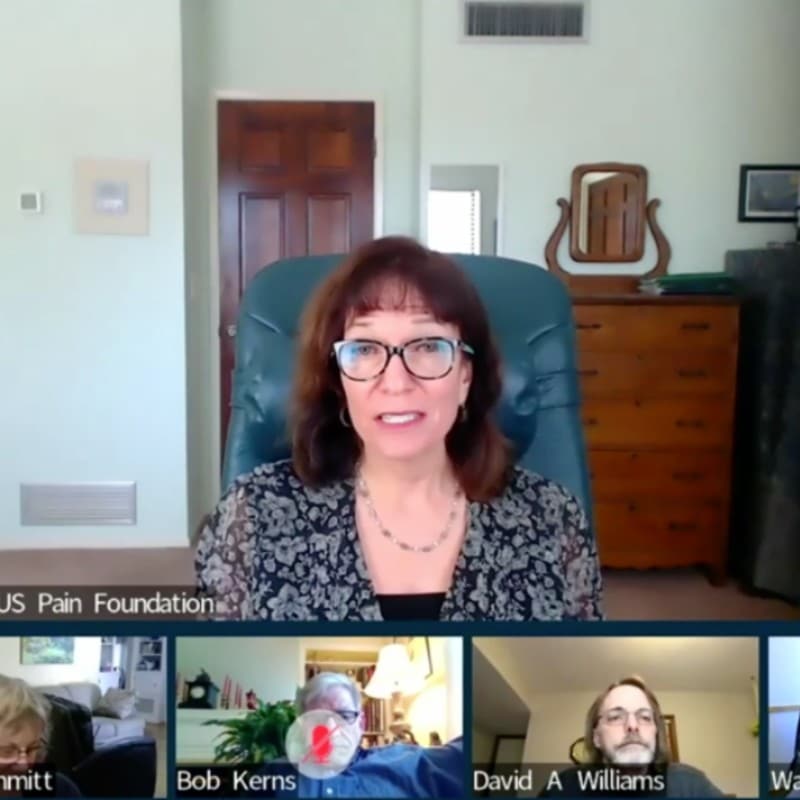
Since 2017, Gwenn Herman, LCSW, DCSW, Clinical Director of Pain Connection, has served as a public member/patient advocate on the Interagency Pain Research Coordinating Committee (IPRCC), the highest-ranking permanent pain policy committee in the United States, which was mandated by Congress under the Affordable Care Act. The goal of the IPRCC is to “enhance pain research efforts and promote collaboration across the government, with the ultimate goals of advancing fundamental understanding of pain and improving pain-related treatment strategies.” The committee, which meets twice a year, convened virtually on Nov. 23 to discuss a number of topics related to pain research and clinical care.
Herman co-led an afternoon session, “Patient Engagement in Clinical Pain Research Studies” with David Williams, PhD, discussing the importance of integrating patient involvement in every aspect of the grant process.
“Patients need to be involved from the beginning, including viewing the grant applications and evaluating whether they are relevant and will benefit patients,” says Herman. “We discussed that patients need to be from diverse populations that have a wide range of conditions that create pain. Patients also should not be blamed for low retention rates when possibly the program did not meet their needs, or the health care professionals were not culturally sensitive to the psychosocial aspects of chronic pain. Additionally, committee members discussed the need for patients to be compensated for their time invested in reviewing these applications and grants. The evaluation process, and any summary papers, need to include patients’ views of the programs. These summaries should then be circulated to patient advocacy groups and organizations.”
[su_pullquote align=”right”]
To watch the Nov. 23 session, view the NIH’s videocast site. Herman and Williams’ presentation begins at 2:08.[/su_pullquote]
The Patient-Centered Outcomes Research Institute (PCORI) was mentioned as a good patient-centered model to follow. As a next step, the committee discussed developing a task force/committee to implement these recommendations, funded by the Helping to End Addiction Long-term (HEAL) initiative. Herman volunteered to serve on the task force/committee.
Herman reports that a number of other topics were also discussed, including numerous HEAL Initiative grants studying a range of areas, including acute adolescent pain; treating knee osteopathic pain with non-pharmacological treatments; Veterans Administration efforts on co-occurring conditions being treated with opioids for pain; opioid prescriptions for C-sections; coping skills of cancer survivors; and using ketamine for post-surgery pain and musculoskeletal pain. Some of the trials mentioned were: post-operative pain, TENS and physical therapy for fibromyalgia, mindfulness for low back pain, acupuncture for low back pain for older adults (through Medicare), acupuncture for sickle cell pain, pain consultants in rural populations, and the use of biomarkers.
A CDC representative reported on the newest statistics about pain based on analysis of the 2019 National Health Interview Survey. These statistics showed that 20.4% of adults had chronic pain and 7.4% of adults had chronic pain that frequently limited life or work activities (referred to as high-impact chronic pain), or roughly 51 million and 19 million, respectively. Chronic pain and high-impact chronic pain both increased with age and were highest among adults aged 65 and over.
Additional reports and discussions were held on how persistent pain alters the rewarding and motivational properties of opioids, the Interagency Pain Research Portfolio database, diversity in pain research, inclusion and retention of diverse populations in clinical pain research studies, enhancing diversity in the pain research workforce, and promoting a new range of investigators.
To learn more about the IPRCC, visit the IPRCC website. To watch the Nov. 23 session, view the NIH’s videocast site. Herman and Williams’ presentation begins at 2:08.
